
Top 4 Magento Monitoring Tools For Performance Monitoring
Ready to take your Magento store to the next level with advanced monitoring tools? Magento monitoring tools optimize your Magento website's performance and ensure a smooth user experience. In this article, we'll explore the top 4 Magento monitoring tools. These tools can help you track and optimize your Magento website.
Key Takeaways
-
Discover the importance of Magento performance monitoring for your eCommerce success.
-
Learn about various monitoring methods.
-
Understand their significance in optimizing your Magento website's performance.
-
Explore the top 4 Magento monitoring tools, including their key features and benefits.
What is Magento Performance Monitoring?
Magento performance monitoring involves observing and analyzing the speed, responsiveness, and efficiency of Magento eCommerce website.
Granular insights from Magento monitoring tools highlight specific pages, database queries, or application dependencies that are underperforming. With this data, developers can target their optimization efforts for maximum impact. Magento performance monitoring involves tracking various performance metrics, such as:
-
Page load times
-
Server response times
-
Database query execution times
It ensures a smooth and fast user experience for visitors. Effective Magento performance monitoring entails:
-
The continuous collection and analysis of performance data
-
Identifying and detecting slowdowns or congestion on the website.
-
Addressing them prevents an impact on user experience or lost sales opportunities.
Monitoring Methods For Magento Website Monitoring
1. Server Monitoring
-
Tracks the health and performance of the server hosting Magento.
-
Monitors metrics such as CPU usage, memory use, disk I/O, and network traffic.
-
Identifies potential resource constraints.
2. Application Monitoring
- Involves monitoring the performance of the Magento application itself. It includes front-end and back-end operations. Tracks metrics such as,
-
Page load times
-
Response times for API requests
-
Database query execution times
3. Database Monitoring
Concentrates on monitoring the performance of the database server hosting Magento's database. It monitors metrics such as
-
Query execution times
-
Table locking
to ensure efficient data retrieval and storage.
4. User Experience Monitoring
-
Focuses on measuring the actual user experience of visitors to the Magento website.
-
Uses tools such as real-user monitoring (RUM). It tracks metrics such as,
-
Page load times
-
Transaction completion rates
-
Error occurrences
5. Third-Party Service Monitoring
Tracks performance and availability of third-party services and integrations used on the website. These services include,
-
Shipping providers
Ensures that these services do not introduce latency or errors.
6. Security Monitoring
Monitors the Magento website for security-related performance issues. Examples include,
-
Denial-of-service(DoS) attacks
-
SQL injection attempts
-
Malicious bot traffic
-
Detects and mitigates security threats promptly.
Prevents them from compromising sensitive data.
6 Benefits of Magento 2 Performance Monitoring
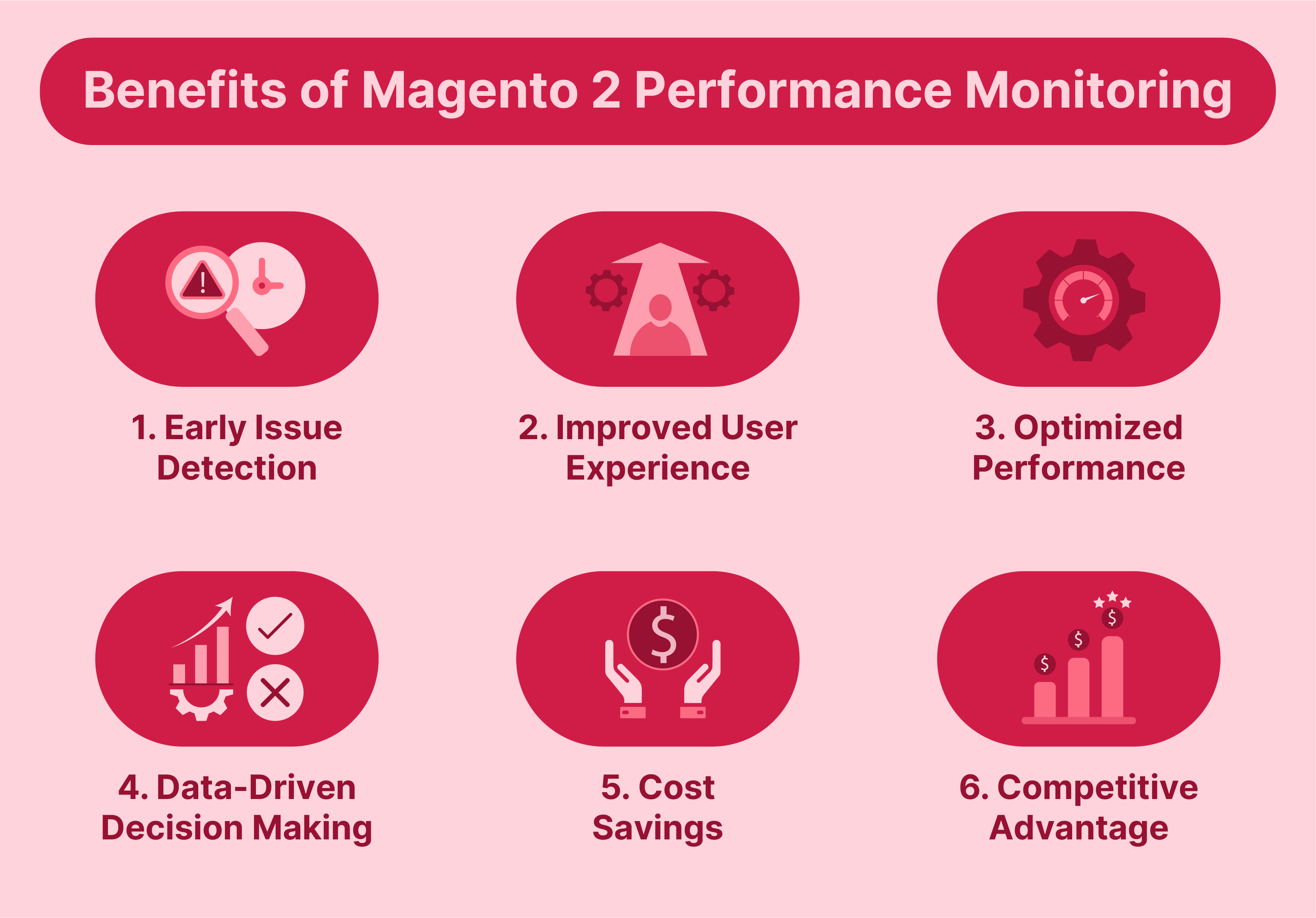
1. Early Issue Detection
-
Continuous Magento monitoring enables early detection of issues. It occurs before they impact the website's performance.
-
For example, if a spike in server response times is detected, it can state a potential server overload. It signals a network issue that needs immediate attention.
-
Identifying issues allows for timely resolution. It minimizes potential revenue loss and ensures customer satisfaction.
-
Addressing slow page load times is important. It can prevent users from abandoning their carts.
2. Improved User Experience
-
Effective performance monitoring results in faster page load times. It leads to smoother navigation, enhancing the customer experience.
-
For example, optimizing image sizes can lead to quicker page loads. It minimizes HTTP requests. A positive user experience leads to:
-
Higher customer satisfaction
-
Increased conversion rates
-
Improved retention
Magento 2 performance monitoring enhances customer loyalty by ensuring a smooth shopping experience.
3. Optimized Performance
-
Performance monitoring identifies areas for optimization within the Magento application. It does so by tracking key performance metrics such as load time and response time.
-
For instance, analyzing database query performance can reveal opportunities. It can show how to optimize SQL queries or use caching strategies.
-
Addressing these areas leads to improved e-commerce performance, efficiency, and responsiveness.
-
Optimized performance leads to faster checkout processes. It also results in smoother navigation.
4. Data-Driven Decision Making
-
Performance monitoring provides valuable data and insights. It helps in making informed decisions about website optimization and resource allocation.
-
Magento performance monitoring maximizes the return on investment. It focuses resources on areas with the most potential for improvement. It does so in website optimization initiatives.
5. Cost Savings
-
It detects and resolves performance issues. It prevents revenue loss due to poor user experiences or website downtime.
-
Identifying and fixing a slow-loading checkout page prevents abandoned carts and lost sales.
-
Ongoing performance monitoring helps Magento website owners reduce costs by avoiding reactive troubleshooting. They can also prevent downtime mitigation costs.
6. Competitive Advantage
-
A well-performing Magento website provides a competitive advantage in the eCommerce market.
-
A fast and responsive website attracts more visitors. It encourages them to explore products and make purchases.
-
Magento performance monitoring enhances user experience, differentiating your website from competitors. It also drives business growth.
Monitoring Tools for Magento Performance Testing
1. New Relic
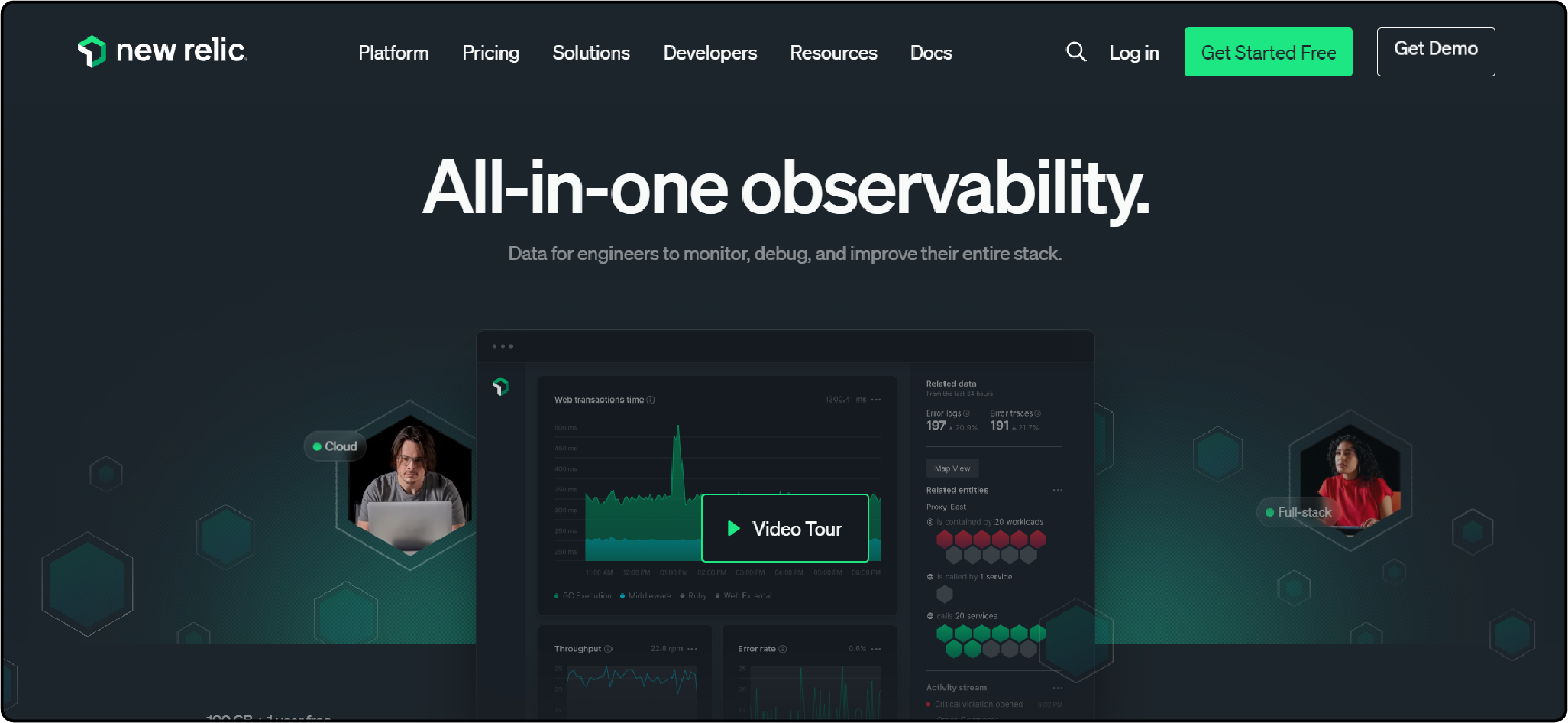
New Relic is a comprehensive Application Performance Monitoring (APM) tool. It provides deep insights into the performance and health of your Magento store. It offers
-
Real-time monitoring
-
Diagnostics
-
Troubleshooting capabilities
Magento-Specific Features
-
Transaction Tracing: Trace transactions through every layer of the Magento application. It includes both the front end and the back end. It allows for detailed performance analysis.
-
Magento-Specific Metrics: Track Magento-specific metrics such as cache hit rate. Track session handling and API performance to identify areas for optimization.
-
Custom Dashboards: Create custom dashboards tailored to Magento’s architecture. These dashboards display key metrics and trends relevant to your store.
2. Datadog
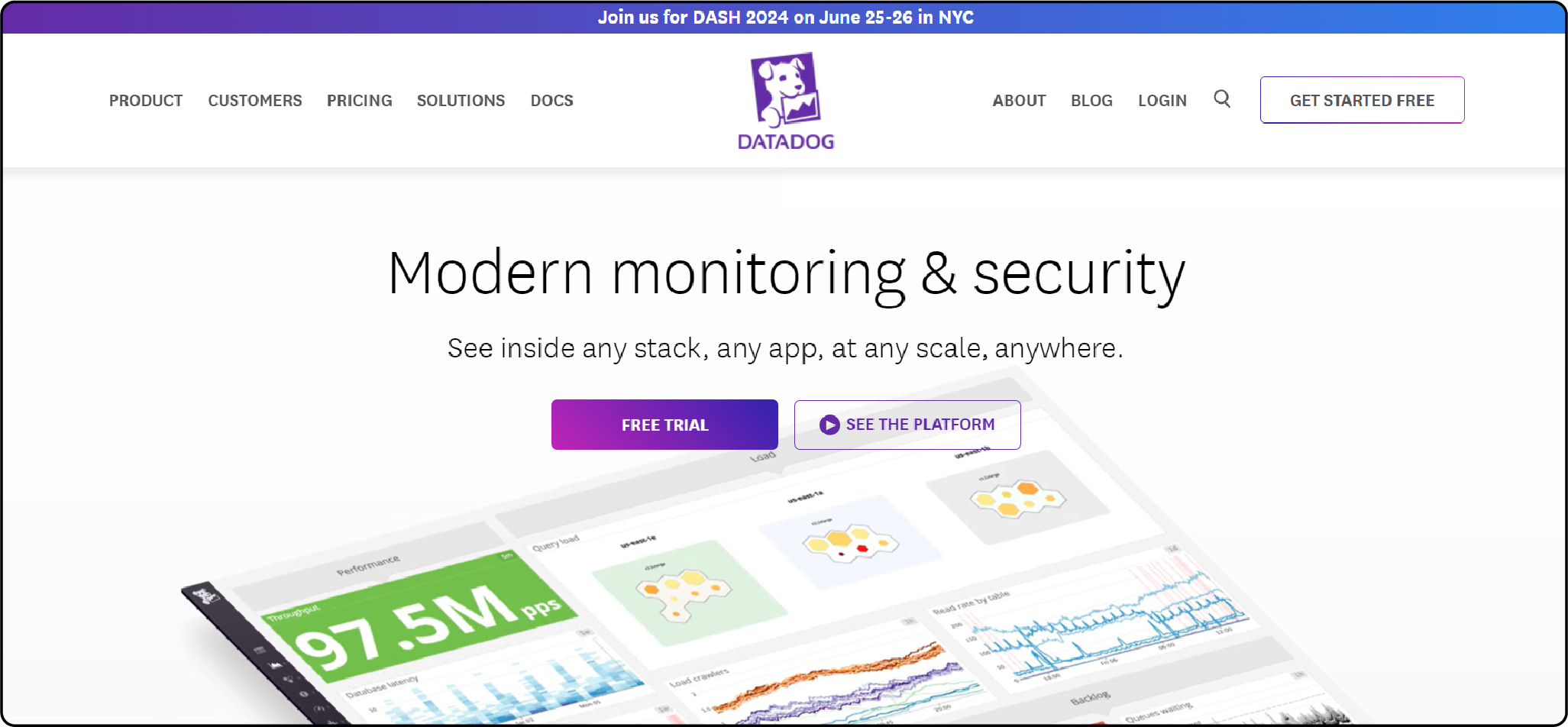
Datadog is a strong monitoring and analytics platform. It provides end-to-end visibility into your Magento infrastructure and applications. It offers a wide range of features for
-
Monitoring
-
Troubleshooting
-
Optimizing performance
Magento-Specific Features
-
Custom Metrics: Collect and visualize custom metrics specific to your Magento deployment. These metrics may include product catalog size, checkout abandonment rate, and customer activity.
-
Intelligent Anomaly Detection: Datadog can detect unusual patterns in Magento metrics. This capability helps detect issues before they impact users.
-
Customizable Alerts: Configure alerts based on Magento-specific thresholds. These thresholds include order processing time or inventory levels. Ensure timely response to critical events by setting up alerts accordingly.
3. Blackfire
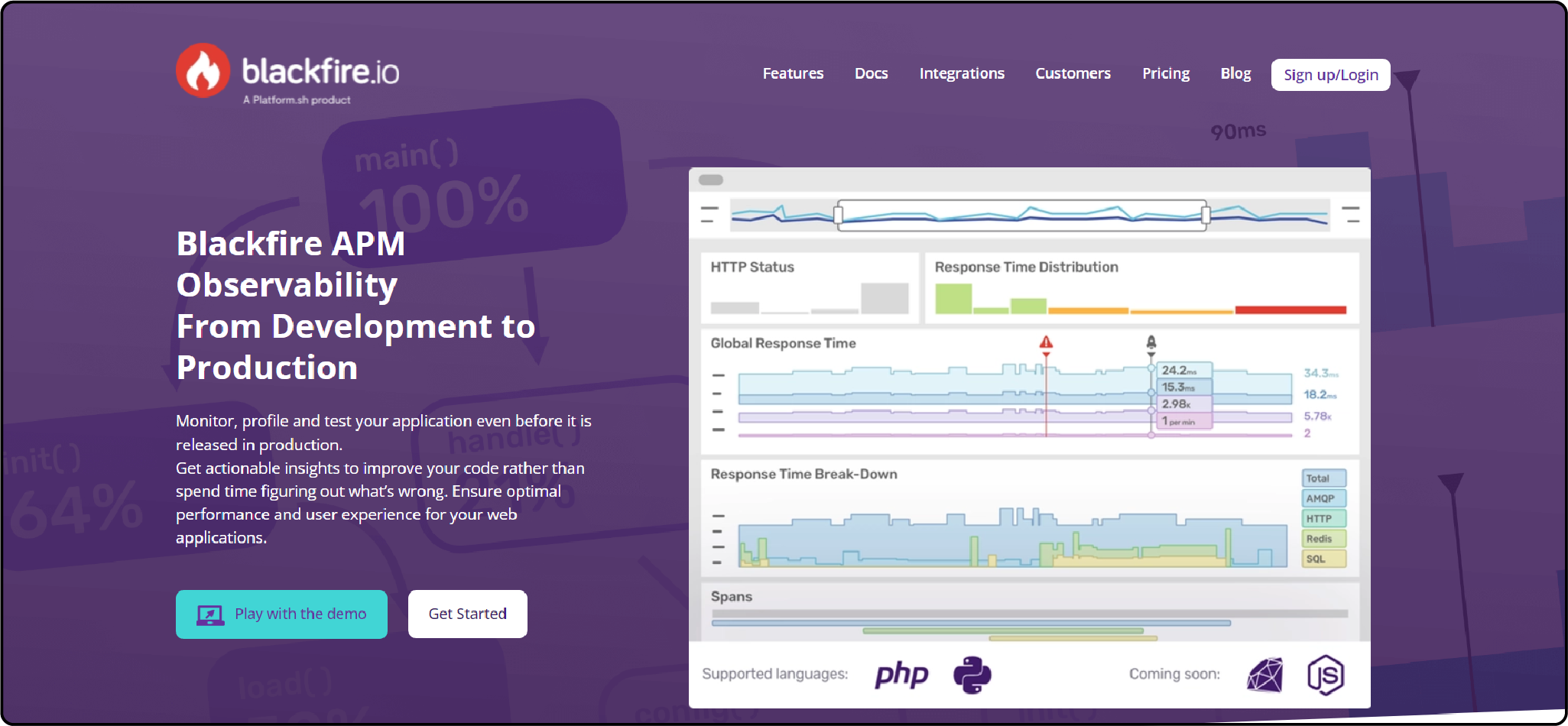
Blackfire is a powerful PHP profiling tool. It helps developers optimize the performance of their Magento applications. It offers detailed insights into
-
Code execution
-
Memory usage
-
Database queries
It enables developers to identify and fix performance bottlenecks.
Magento-Specific Features
-
Magento Code Analysis: Blackfire can analyze the Magento codebase for performance issues. These issues include inefficient database queries, slow-loading pages, and memory leaks.
-
Scenario Testing: Test Magento under different scenarios. These scenarios may include high-traffic loads or complex shopping cart configurations. Ensure scalability and reliability through these tests.
-
Integrations with Magento Development Tools: Blackfire integrates with popular Magento development tools. These include Composer, PhpStorm, and Git. This integration streamlines the optimization workflow.
4. Tideways
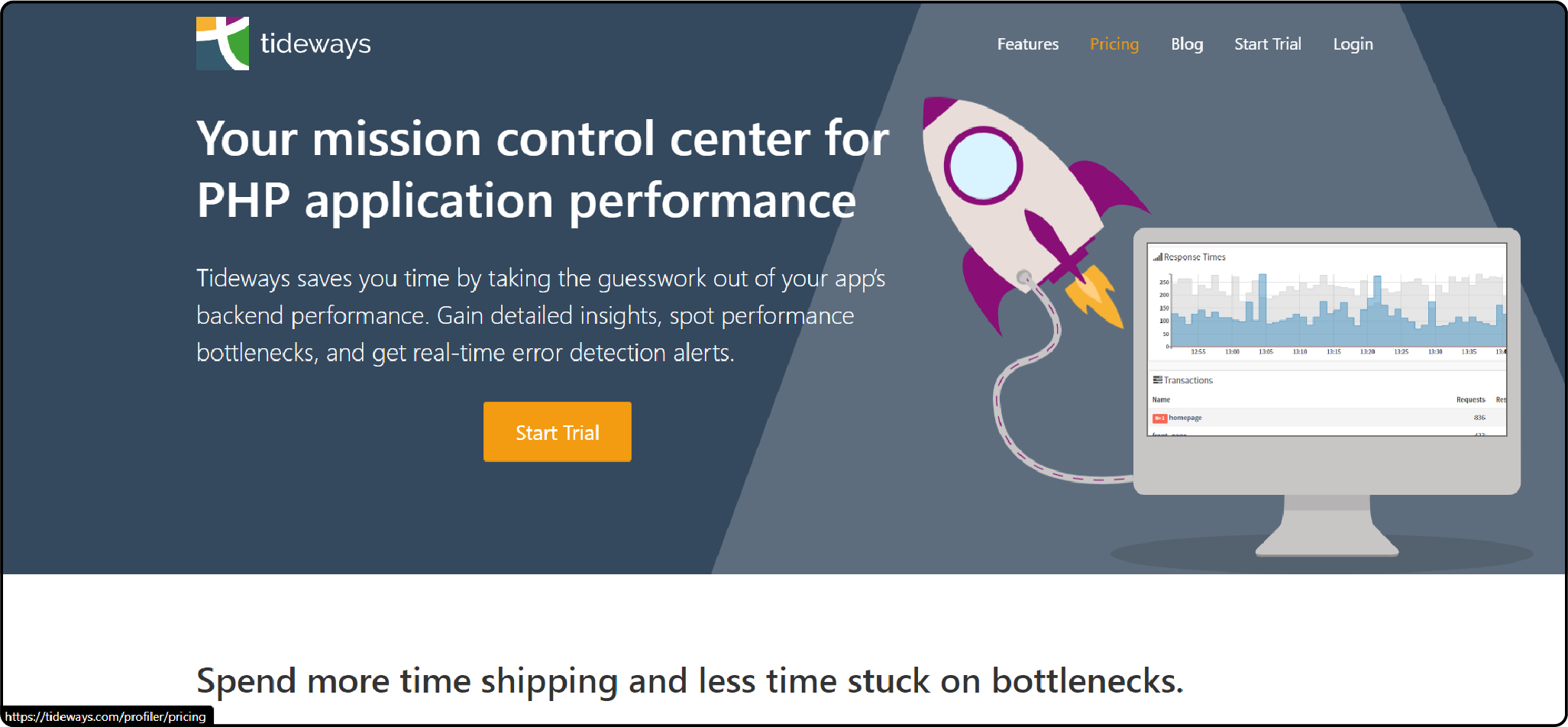
Tideways is an application monitoring service designed for PHP applications. It offers
-
Profiling
-
Monitoring
-
Error-tracking capabilities
It provides developers and operations teams with actionable insights. These insights aim to improve the performance and reliability of Magento stores.
Magento-Specific Features
- Magento Plugin Profiling:
-
Profile the performance impact of Magento plugins and extensions.
-
Identify resource-intensive plugins.
-
Optimize performance accordingly.
-
Custom Error Tracking: Track custom errors and exceptions specific to your Magento deployment. These may include payment gateway failures or inventory synchronization issues. This monitoring approach ensures the timely detection of issues. It also ensures timely resolution of potential problems.
-
Magento Codebase Analysis: Analyze the Magento codebase for common performance pitfalls. Identify best practices for optimization. Provide actionable recommendations for improvement.
Key Magento Metrics to Monitor and Track Magento Site
| Metric | Description |
|---|---|
| Page Load Time | Measures the time for a webpage to fully load in a user's browser. |
| Server Response Time | Indicates how quickly the server responds to requests from users' browsers. |
| Database Query Execution Time | Measures the database server's query execution time for the Magento application. |
| Page Load Distribution | Offers insights on how page load times vary across the website's pages. |
| Conversion Rates | Measures the percentage of visitors who complete a desired action, like purchasing. |
| Bounce Rate | Shows the proportion of visitors who leave the site after seeing just one page. |
| **[Cart Abandonment Rate] | Tracks the rate of users who add items to their cart but exit without buying. |
| Website Availability | Refers to the percentage of time that the website is accessible and operational. |
| Average Session Duration | Measures the average length of time that users spend on the website during a single session. |
| Unique Visitors | Tracks the unique visitors to the website over a specific period. |
| Page Views | Measures the total number of pages viewed by visitors on the website. |
| Traffic Sources | Reveals the sources of website traffic, like search engines or referral sites. |
| Click-Through Rate (CTR) | Measures the percentage of users who click on a specific link or ad compared to the total number of viewers. |
| Average Order Value (AOV) | Measures the average monetary value of orders placed on the website. |
FAQs
1. What are some key metrics to track Magento performance?
Key Magento performance metrics are response time, page load time, and bounce rate.
2. How does external website monitoring contribute to Magento performance monitoring?
External website monitoring helps you identify issues outside of your Magento site. Issues like slow third-party services or content delivery networks may impact performance.
3. Are there specific tools recommended for Magento 2 performance monitoring?
Yes, there are several tools available. These include New Relic, Datadog, and Blackfire. They track and test Magento 2 performance.
4. How can Magento monitoring tools help improve customer experience?
Magento monitoring tools can help you identify performance issues quickly. They ensure that your Magento store provides a smooth customer experience.
5. What is the importance of real-time monitoring for Magento performance?
Real-time monitoring provides immediate insights into the performance of your Magento site. It allows you to address issues promptly and maintain optimal performance.
6. How can load testing tools benefit Magento store performance?
Load testing tools simulate high-traffic scenarios. They assess how your Magento store performs under pressure. It helps you optimize its performance and scalability.
7. How do Magento monitoring tools help in reducing bounce rate?
By monitoring key performance metrics, Magento monitoring tools can help identify issues. They can also track user experience factors. These tools can also help address issues that contribute to high bounce rates on your store.
Summary
Magento monitoring tools oversee the performance of your Magento-powered eCommerce website. Their goal is to ensure its efficiency and success. Here's a recap of the key points covered:
- It detects issues early and ensures scalability for a smooth user experience.
- The top tools are New Relic, Datadog, Blackfire, and Tideways. They offer unique features for tracking metrics and detecting anomalies.
- Implementing these methods and tools enables proactive maintenance. It also provides a competitive edge in eCommerce.
Always opt for a recommended managed Magento hosting provider and use monitoring tools for optimal website performance.



